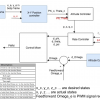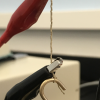During summer time, our goal is to try to achive a single motor&propeller helicopter on Crazyflie by removing three propellers and motors. Week one and two, we measured the thrust on a single motor of crazyflie by diving the total thrust of four motors by four. We found the thrust is not enough to l...
This week, I finally decided my project for this summer with Prof. Mehta. Based on the framework that we developed for cooperative localization, we further consider how to optimize (or minimize the cost) this process with constrained resource. This paper may be the most related one, and I will f...
This week I worked with Jerry, Likai and Carol to test Crazyflie's thrust force. We used the method from [1] to measure the thrust force created by one motor and one propeller on crazyflie with different PWM signal. From the measurement, we conclude the system needs more than one motor to provide en...
Robot made of paper and supercoiled polymer actuators (SCP). Get the robot to move somehow (walking, rolling, etc.). Use a motor control or phone to control the robot. Program the arms to move to positions 1,2,3 and be able to grab onto different objects (e.g. metal can, glass bottle, paper ball). Read more articles & journals, searching for key words I want to focus on. Delve more into taking weight into consideration & how heavy a load the paper robot can withstand. Investigate ways of folding the paper & what shapes would give it the most strength, durability, & efficiency. Technology for a robot or other such device to recognize trash, recyclebles, & compost does not yet exist, but we can build & design & research for that idea.
Last quarter I continued the study of drone simulations and focused on Crazyflie 2.0. By reading Crazyflie’s Technical Report: Design of a Trajectory Tracking Controller for a Nanoquadcopter [1] and looking into Crazyflie’s source codes[2], I had better understanding of the control algorithms used b...
When I first joined this research group I started working with the RoCo team helping them with documentation and improving file formatting. I then started working on a side project: a paper bot powered by a phone that could be designed using RoCo. At the beginning I mainly focused on how to allow co...
Recap: After attending to several weekly group meetings, I officially joined UCLA Lemur at the beginning of Spring 2017. I decide to work on the underactuated flying robot swarm project. The main objective of the project is to create to a swarm of underactuated robots that are able to cooperate. Th...
Over the course of the spring quarter, I have been working on the transition from understanding the theory behind super coiled polymer actuators to developing the actual manufacturing process for these actuators. This experience has invoked in me a greater appreciation not only for the overall “rese...
Summary of my past research progress During my time at UCLA as an exchange student, I got to join LEMUR and worked as an undergraduate researcher for the Winter and Spring quarter. I was responsible for high and low level testing of the robot compiler (RoCo). I completed the test code for the Pa...
Over this past quarter, I have been working on refactoring and improving the RoCo API, and merging the mechanical, electrical, and code interfaces in an organic manner that lets the users work on different parts of the robot concurrently. Working on RoCo Over the first two quarters of the past...

